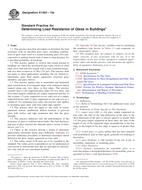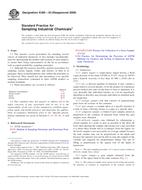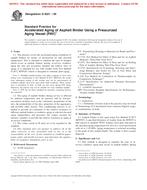1.1 These test methods cover procedures for the determination of the fiber blend composition of mixtures of the fibers listed in 1.2. Procedures for quantitative estimation of the amount of moisture and certain nonfibrous materials in textiles are also described, for use in the analysis of mixtures, but these are not the primary methods for the determination of moisture content for commercial weights.
1.2 These test methods cover procedures for the following fiber types:
1.2.1 Natural Fibers:
1.2.1.1 Cellulose-Base Fibers:
Cotton
Hemp
Flax
Ramie
1.2.1.2 Protein-Base Fibers:
Animal hairs (other than wool)
Silk, cultivated
Silk, Tussah
Wool
1.2.2 Man-Made Fibers:
1.2.2.1 Cellulose-Base Fibers:
Acetate (secondary)
Rayon, viscose or cuprammonium
Triacetate
1.2.2.2 Synthetic-Base Fibers:
Acrylic
Aramid
Modacrylic
Nylon 6, Nylon 6-6, others
Olefin
Polyester
Spandex
1.3 These test methods include the following sections and tables:
| Section | |
|---|---|
| Referenced Documents | 2 |
| Terminology | 3 |
| Summary of Methods | 4 |
| Uses and Significance | 5 |
| Sampling | 7 |
| Purity of Reagents | 6 |
| Moisture Content or Moisture Regain | 9 |
| Nonfibrous Materials | 8 |
| Mechanical Separation or Dissection | 10 |
| Chemical Test Methods: | |
| Summary of Methods | 11 |
| Specimens and Symbols | 12 |
| No. 1 Acetate Mixed With Other Fibers | 13 |
| No. 2 Modacrylic Mixed With Cellulosic Fiber or Wool | 14 |
| No. 3 Nylon 6 or Nylon 6-6 Mixed With Natural Fibers or Rayon | 15 |
| No. 4 Rayon Mixed With Cotton | 16 |
| No. 5 Wool or Polyester Mixed With Cellulosic Fibers or Silk | 17 |
| No. 6 Polyester or Acrylic Mixed With Wool | 18 |
| No. 7 Natural Cellulosic Material and Rayon Mixed With Acrylic, Modacrylic, and Polyester | 19 |
| No. 8 Polyester Mixed With Olefin | 20 |
| No. 9 Polyester Mixed With Acetate or Nylon 6,6-6 | 21 |
| No. 10 Acrylic Fiber or Linear Spandex Mixed With Nylon or Polyester | 22 |
| Microspical Analysis | |
| Scope | 23 |
| Summary of Method | 24 |
| Sampling | 26 |
| Apparatus | 25 |
| Procedure | 27 |
| Indexing Term | 28 |
| Table | |
| Chemical Methods for Analysis of Fiber Mixtures | 1 |
| Solubilities of Various Fibers in Solvents Used in Chemical Methods |
2 |
| Comparative Scale for Fineness of Various Textile Fibers | 3 |
| Fineness Ranges and Fiber Diameters of Various Textile Fibers | 4 |
| Specific Gravity of Various Textile Fibers | 5 |
1.4 The analytical procedures described in the test methods are applicable to the fibers listed in 1.2. The test methods are not satisfactory for the separation of mixtures containing fibers that fall within the same generic class but differ somewhat, either physically or chemically, from each other. These test methods are not satisfactory for the determination of bicomponent fibers.
Note 1 – For other methods of analysis covering specific determinations, refer to: Test Methods D 461, Test Method D 584, Methods D 885, Test Method D 1113, Test Method D 1334, and Test Method D 2130. Methods for moisture are covered in Methods D 885, Test Method D 1576, Test Method D 2462, Test Method D 2495 and Test Methods D 2654. For the determination of commercial weight, refer to Test Method D 2494.
1.5 This standard does not purport to address all of the safety concerns, if any, associated with its use. It is the responsibility of the user of this standard to establish appropriate safety and health practices and determine the applicability of regulatory limitations prior to use.
23.1 The following procedures may be used for the quantitative analysis of textiles containing two or more types of fibers that cannot be readily separated chemically. If the sample contains both animal and vegetable fibers, a mechanical separation (Section 10) or a chemical analysis (Sections 11-22) shall first be made. The percentages of the different types of fibers in these two groups shall then be determined by the appropriate method as directed in Sections 24 and 26. The accuracy obtainable with microscopical methods depends to a considerable extent upon the ability of the analyst to identify the different fibers present in the mixture and also upon the number of fibers examined and the number measured.
Note 22 – Photomicrographs of common textile fibers are appended to AATCC Method 20.
Product Details
- Published:
- 08/01/2008
- Number of Pages:
- 22
- File Size:
- 1 file , 360 KB
- Redline File Size:
- 2 files , 670 KB


